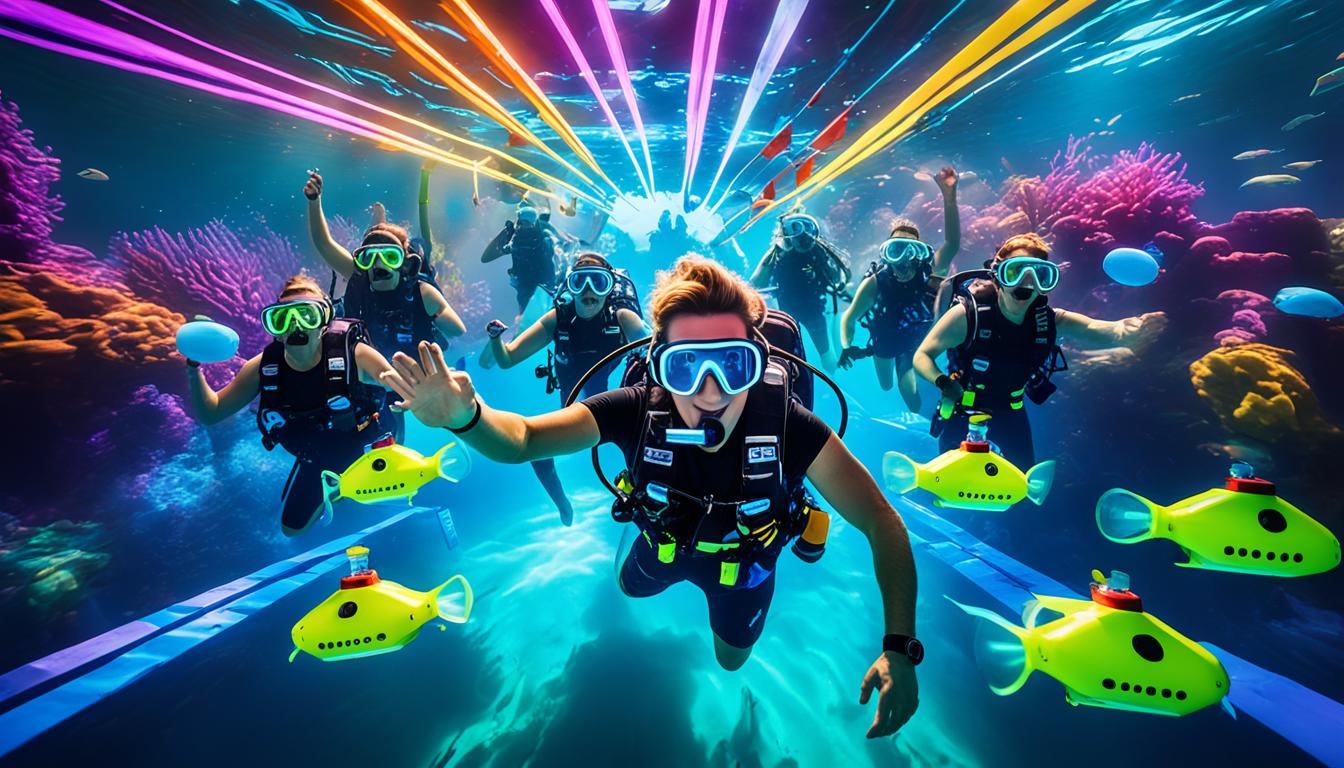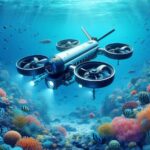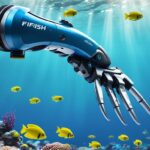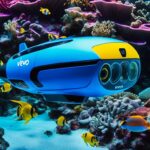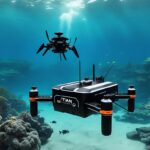Marine research and exploration have undergone a significant transformation in recent years, thanks to the incredible advancements in underwater drone technology. These sophisticated devices have revolutionized the way we study and understand the vast depths of our oceans. From underwater robotics to oceanography technology, the impact of underwater drones on marine science advancements cannot be overstated.
Key Takeaways:
- Underwater drones have revolutionized marine research by enabling scientists to explore previously inaccessible areas.
- They have enhanced the efficiency and accuracy of data collection in underwater environments.
- Underwater drones play a crucial role in marine conservation efforts, aiding in the study and preservation of marine ecosystems.
- Technological advancements in underwater robotics have paved the way for groundbreaking discoveries in marine science.
- The future prospects of underwater drones in marine research are promising, with emerging technologies set to further revolutionize exploration and discovery.
The Rise of Underwater Drones in Marine Exploration
Over the years, the field of marine exploration has undergone a significant transformation with the emergence of underwater drones. These cutting-edge devices have revolutionized traditional marine research methods, allowing scientists to explore the depths of the ocean like never before. Powered by advanced underwater technology, autonomous underwater vehicles (AUVs), or commonly known as underwater drones, have gained popularity for their versatility, efficiency, and remarkable capabilities.
One of the key factors contributing to the rise of underwater drones in marine exploration is their ability to navigate underwater environments autonomously. Equipped with sophisticated sensors and artificial intelligence technology, these drones can efficiently map the ocean floor, collect valuable data, and capture high-resolution images and videos of marine life and underwater ecosystems.
Underwater drones enable scientists to access areas that are too difficult or dangerous for humans to explore. They provide researchers with a cost-effective and efficient means of conducting marine research, revolutionizing our understanding of the oceans and its inhabitants.
These autonomous underwater vehicles have numerous features that make them essential tools in marine exploration. They are equipped with advanced imaging systems, such as sonars and cameras, allowing scientists to study marine organisms, geological formations, and underwater structures in unprecedented detail. By efficiently collecting data in real-time, underwater drones save time and resources, enabling researchers to gather critical information for scientific studies and conservation efforts.
Moreover, underwater drones have the ability to operate in challenging and extreme underwater conditions for extended periods. This endurance enables researchers to conduct long-term studies, monitor changes in marine ecosystems, and observe patterns and behaviors of marine species in their natural habitats.
The Capabilities of Underwater Drones:
- Autonomous navigation and mapping
- High-resolution imaging and video recording
- Data collection in real-time
- Extended operational endurance
- Exploration of deep-sea environments
- Conducting scientific experiments and measurements
The rise of underwater drones in marine exploration has not only expanded our knowledge of the oceans but also contributed to various fields of study, including oceanography, biology, archaeology, and geology. These remarkable technological advancements have opened up new opportunities for groundbreaking scientific discoveries and conservation efforts.
As underwater drone technology continues to advance, we can expect even more remarkable developments in marine research and exploration. The future holds great promise for the use of underwater drones in unraveling the mysteries of the deep sea and gaining a deeper understanding of our marine ecosystems.
| Advantages of Underwater Drones in Marine Exploration | Challenges in Marine Exploration |
|---|---|
| 1. Efficient data collection and analysis | 1. Unpredictable and harsh underwater conditions |
| 2. Accessibility to remote and hazardous areas | 2. Limited human reach and endurance |
| 3. Real-time monitoring and observation | 3. High costs associated with advanced underwater technology |
| 4. Versatile applications in various scientific disciplines | 4. Limited battery life and storage capacity |
As we explore the immense potential of underwater drones, it becomes clear that these remarkable devices are vital tools in marine research and exploration. They have paved the way for scientific breakthroughs and have become crucial aids in understanding and preserving our marine environment.
Advancements in Underwater Robotics for Marine Research
Underwater drones have revolutionized the field of marine research, enabling scientists to explore the depths of our oceans in ways that were once unimaginable. These technological marvels, also known as underwater robotics, have undergone significant advancements, propelling marine science to new heights.
State-of-the-art underwater drone technology has paved the way for groundbreaking discoveries and marine science advancements. These robots are equipped with advanced sensors, cameras, and imaging systems, allowing researchers to capture high-resolution images and videos of underwater environments and marine life.
“The development of sophisticated underwater drone technology has brought about a paradigm shift in marine research. It has empowered researchers to investigate the ocean depths and unlock the mysteries hidden beneath the surface,”
states Dr. Elizabeth Wilson, a renowned marine biologist.
One of the key advancements in underwater robotics is the integration of autonomous capabilities. These drones can operate independently, following pre-programmed routes or utilizing artificial intelligence algorithms to make real-time decisions. This autonomy allows researchers to collect vast amounts of data efficiently and accurately.
With the ability to dive to great depths and withstand challenging underwater conditions, underwater drones have become indispensable tools for marine research. Their maneuverability and versatility enable scientists to conduct a wide range of experiments, collect samples, and monitor delicate marine ecosystems without disturbing their natural habitats.
The development of underwater drone technology has also contributed to significant improvements in data collection. These robots can collect valuable scientific data, such as water temperature, pH levels, salinity, and underwater currents, with precision and accuracy. This data provides scientists with valuable insights into the health and dynamics of marine ecosystems.
The Impact of Underwater Robotics
The advancements in underwater robotics have had a profound impact on marine science. Researchers are now able to explore previously inaccessible areas of the ocean, uncovering hidden biodiversity and discovering new marine species. The detailed imagery and data collected by underwater drones have led to groundbreaking scientific discoveries and a deeper understanding of our marine ecosystems.
The use of underwater drones in marine research has also accelerated conservation efforts. These robots play a crucial role in monitoring endangered species, tracking changes in the ocean environment, and assessing the impact of human activities on marine ecosystems. By providing real-time data, underwater drones enable scientists and conservationists to make informed decisions and implement effective conservation strategies.
As underwater robotics continues to advance, the future of marine research looks promising. Researchers are constantly pushing the boundaries of technology to develop even more capable and efficient underwater drones. These advancements will undoubtedly lead to further breakthroughs in marine science and our understanding of the complex underwater world.
| Advancements in Underwater Robotics | Impact on Marine Research |
|---|---|
| Integration of autonomous capabilities | Efficient data collection and exploration of previously inaccessible areas |
| Enhanced sensors and imaging systems | High-resolution imagery and data for scientific analysis |
| Improved maneuverability and versatility | Non-intrusive monitoring of marine ecosystems |
| Precision data collection | Deeper understanding of marine biodiversity and ecosystem dynamics |
With these advancements, underwater robotics continues to revolutionize marine research, pushing the boundaries of our scientific knowledge and opening new avenues for exploration in the mesmerizing world beneath the waves.
Enabling Efficient Data Collection in Underwater Environments
Underwater drones have revolutionized the way data collection is conducted in underwater environments, providing marine researchers with advanced tools for gathering valuable scientific information. The use of underwater drones in marine research has greatly improved efficiency and accuracy, leading to significant advancements in the field.
One of the key benefits of underwater drones in data collection is their ability to reach depths and locations that are otherwise inaccessible to humans. These drones are equipped with advanced sensors and imaging systems, allowing them to capture high-resolution images, videos, and environmental data.
By using underwater drones, marine researchers can collect crucial information about underwater ecosystems, marine species, and oceanographic phenomena without disturbing the natural environment. This non-invasive approach to data collection has opened up new possibilities for studying marine life and understanding underwater ecosystems.
The underwater drones are also equipped with cutting-edge navigation systems, allowing them to navigate through underwater environments with precision. This enables researchers to create detailed maps, identify specific locations of interest, and track changes over time. These capabilities have greatly enhanced the accuracy and efficiency of marine research.
“Underwater drones have transformed the way we collect data in marine research. These autonomous devices provide us with valuable insights into the underwater world, helping us unravel the mysteries of the ocean.”
– Dr. Emily Thompson, Marine Scientist
The efficient data collection facilitated by underwater drones has accelerated marine science advancements in various disciplines. Oceanographers can now analyze large volumes of data collected by multiple drones simultaneously, allowing for more comprehensive and detailed research.
Additionally, underwater drones can be deployed for extended periods of time, taking advantage of their autonomous capabilities. This enables continuous data collection and long-term monitoring, providing researchers with invaluable long-term insights into underwater environments.
Underwater Data Collection with Underwater Drones – Benefits at a Glance:
- Access to inaccessible locations and depths
- High-resolution imaging and video capabilities
- Non-invasive data collection
- Precise navigation systems
- Creation of detailed maps and tracking of changes
- Efficient analysis of large volumes of data
- Continuous data collection and long-term monitoring
The utilization of underwater drones for data collection has transformed marine research by providing researchers with a powerful toolset for underwater exploration and analysis. These advancements have accelerated our understanding of underwater ecosystems and propelled marine science into new frontiers.
Enhancing Marine Conservation Efforts with Underwater Drones
Underwater drones are not only revolutionizing marine research but also playing a crucial role in enhancing marine conservation efforts. With their advanced capabilities and cutting-edge technologies, these underwater research technologies have become invaluable tools for studying marine ecosystems, monitoring endangered species, and contributing to the preservation of delicate marine environments.
One of the key applications of underwater drones in marine conservation is the study of marine ecosystems. These drones enable researchers to explore and document underwater habitats with unprecedented precision and detail. By collecting data on biodiversity, fish populations, and coral reef health, scientists gain a deeper understanding of the delicate balance within marine ecosystems and can implement targeted conservation strategies.
Furthermore, underwater drones play a vital role in monitoring endangered species and their habitats. With their ability to navigate challenging underwater environments, these drones can reach inaccessible areas and collect critical data on the behavior, distribution, and abundance of endangered marine species. This information helps scientists develop conservation plans and implement measures to protect these vulnerable populations.
Underwater drones also contribute to the preservation of marine environments by aiding in the identification and management of potential threats. These drones are equipped with various sensors and imaging technologies that can detect and monitor underwater pollution, invasive species, and the impact of climate change. By gathering accurate data on these threats, conservationists can take proactive measures to mitigate their effects and protect marine ecosystems.
“Underwater drones are revolutionizing marine conservation by providing scientists with unprecedented access to underwater environments, enabling them to study marine ecosystems, monitor endangered species, and protect the delicate balance of our oceans.”
In addition to their data collection capabilities, underwater drones also assist in the development and implementation of marine protected areas (MPAs). These drones can provide real-time surveillance and enforcement, helping authorities detect and prevent illegal fishing activities, poaching, and unlawful exploitation of marine resources. By ensuring the effective management of MPAs, underwater drones promote the long-term conservation of marine biodiversity and habitats.
Underwater Drone Applications in Marine Conservation:
| Application | Description |
|---|---|
| Marine Ecosystem Study | Using underwater drones to examine biodiversity, fish populations, and coral reef health to inform conservation strategies. |
| Endangered Species Monitoring | Utilizing underwater drones to collect data on behavior, distribution, and abundance of endangered marine species. |
| Threat Identification and Management | Deploying underwater drones to detect and monitor underwater pollution, invasive species, and climate change impacts. |
| Marine Protected Area Surveillance | Enabling real-time surveillance and enforcement to prevent illegal fishing and protect marine resources. |
By harnessing the power of underwater drones, marine conservation efforts are being elevated to new heights. With their ability to navigate underwater environments and collect valuable data, these technologies enable scientists and conservationists to make informed decisions, implement effective measures, and safeguard the future of our marine ecosystems.
Remote Underwater Sensing for Advanced Marine Research
Remote underwater sensing plays a crucial role in advancing marine research by allowing scientists to collect precious data and perform experiments in challenging underwater environments. The use of underwater drones has revolutionized the way researchers gather information and conduct studies, leading to significant advancements in marine science.
With the advent of underwater drones, scientists can remotely explore the depths of the ocean and access areas that were previously inaccessible. These highly advanced devices equipped with cutting-edge technology enable researchers to capture valuable data and images, providing valuable insights into marine ecosystems, underwater geological formations, and various underwater phenomena.
The remote capabilities of underwater drones have proven to be especially beneficial in conducting underwater surveys without disturbing fragile marine habitats. By remotely operating these drones, scientists can observe marine life and behaviors with minimal interference, ensuring the accuracy and objectivity of their research.
One of the key advantages of remote underwater sensing is its ability to overcome the limitations of human exploration in extreme underwater conditions. Underwater drones can withstand immense pressures, extreme temperatures, and challenging visibility, allowing researchers to gather data in environments that would otherwise be hazardous or impossible to navigate.
Furthermore, remote underwater sensing with underwater drones enables real-time data transmission, providing scientists with instant access to crucial information. This immediate feedback enhances the efficiency and effectiveness of research, enabling scientists to make timely decisions and adjust their strategies accordingly.
Remote underwater sensing has also opened up new possibilities for collaborative research. Scientists from different parts of the world can share data and insights, facilitating global knowledge exchange and promoting cooperation in marine science advancements.
Advancements in Remote Underwater Sensing Technologies
The field of remote underwater sensing continues to evolve rapidly. Researchers are constantly developing and implementing new technologies to improve the capabilities of underwater drones for marine research purposes.
| New Sensor Technologies | Enhanced Data Transmission | Autonomous Navigation |
|---|---|---|
| Innovative sensor technologies, such as high-resolution cameras, sonar systems, and environmental sensors, enable underwater drones to capture detailed data and images. | Advanced data transmission systems enable real-time streaming of data, making it accessible to researchers and facilitating immediate analysis. | Autonomous navigation systems allow underwater drones to operate independently, collecting data from designated locations and following predetermined routes. |
These advancements are revolutionizing marine research by expanding the possibilities of data collection and analysis, enabling scientists to gain deeper insights into the underwater world. As remote underwater sensing technology continues to evolve, researchers are uncovering new discoveries, improving conservation efforts, and unlocking the mysteries of the marine realm.
Applications of Underwater Drones in Oceanography Research
Underwater drones have revolutionized the field of oceanography research, offering scientists a versatile and efficient tool for exploring the depths of our oceans. With their advanced technology and maneuverability, these underwater exploration tools have opened up new possibilities for studying marine ecosystems, mapping ocean currents, and investigating underwater phenomena.
Mapping Ocean Currents
One of the key applications of underwater drones in oceanography research is the mapping of ocean currents. These currents play a crucial role in the transport of heat, nutrients, and marine life across vast distances. By deploying underwater drones equipped with specialized sensors, scientists can collect data on temperature, salinity, and water flow rates to create accurate models of ocean currents. This information is invaluable for understanding global climate patterns, predicting weather events, and managing marine resources.
Studying Marine Geology
Underwater drones also enable researchers to study marine geology in unprecedented detail. Equipped with high-resolution cameras and sonar systems, these drones can capture images and create detailed maps of the seafloor, underwater mountains, and canyons. By analyzing these geological features, scientists can gain insights into plate tectonics, volcanic activity, and the formation of underwater landforms. This knowledge is essential for understanding Earth’s geologic history and predicting natural hazards.
Investigating Underwater Phenomena
The use of underwater drones has revolutionized our ability to investigate underwater phenomena that were previously inaccessible. From studying deep-sea hydrothermal vents to observing the behavior of marine organisms, these drones provide a unique perspective on underwater ecosystems. They can capture high-definition video footage, collect samples, and monitor environmental parameters in real-time. This allows scientists to unravel the mysteries of the deep sea and gain a deeper understanding of marine life and its complexity.
By advancing our understanding of oceanography through the use of underwater drones, researchers can contribute to conserving and protecting our marine environments. These innovative technologies not only enhance our knowledge of the world’s oceans but also provide critical insights for sustainable management of marine resources. As oceanography technology continues to advance, we can look forward to even more groundbreaking discoveries and marine science advancements in the future.
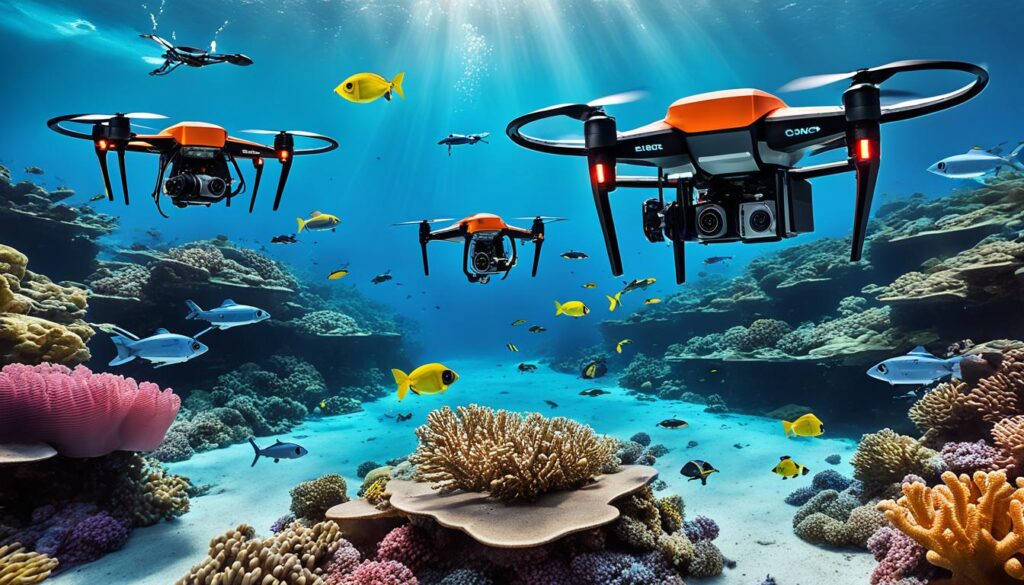
Expanding Our Knowledge of the Oceans with Underwater Drones
Underwater drones have emerged as invaluable tools for expanding our understanding of the vast and mysterious oceans. These cutting-edge devices have revolutionized marine research, enabling scientists to delve into previously inaccessible areas, discover new marine species, and conduct in-depth studies of underwater ecosystems.
By harnessing the power of underwater technology, researchers have unlocked a new era of marine exploration. Underwater drones, also known as autonomous underwater vehicles (AUVs), are equipped with advanced sensors and imaging systems that capture high-resolution data, allowing scientists to study the oceans with unprecedented detail and accuracy.
One of the key advantages of underwater drones is their ability to reach extreme depths and withstand harsh underwater conditions. They can navigate intricate underwater terrains, explore underwater caves, and survey vast stretches of the ocean floor. This unparalleled access to remote and unexplored regions has opened up endless possibilities for marine scientists.
The data collected by these underwater drones has led to groundbreaking marine science advancements. Through comprehensive mapping and imaging capabilities, researchers have gained valuable insights into marine biodiversity, helping identify new species and understand their habitats. This knowledge is crucial for conservation efforts and aids in the preservation of fragile marine ecosystems.
Furthermore, underwater drones have played a pivotal role in studying underwater geological formations and oceanic phenomena. From underwater volcanoes to deep-sea trenches, these devices provide invaluable data that contributes to our understanding of Earth’s geology and the forces shaping our planet.
Underwater drones have also proven to be instrumental in understanding the effects of climate change on marine environments. By monitoring changes in water temperature, acidity levels, and the health of coral reefs, scientists can gain a deeper understanding of how these ecosystems are adapting to global shifts. This knowledge is crucial for developing effective conservation strategies.
To showcase the impact of underwater drones in expanding our knowledge of the oceans, here is a table summarizing some notable marine research achievements facilitated by these remarkable devices:
| Research Area | Key Findings |
|---|---|
| Deep-Sea Exploration | Discovered previously unknown species thriving in extreme depths |
| Coral Reef Studies | Monitored coral bleaching events and identified factors contributing to reef decline |
| Underwater Archaeology | Uncovered ancient shipwrecks and artifacts, providing insights into maritime history |
| Marine Mammal Research | Tracked migration patterns and behavior of whales and dolphins |
As technology continues to advance, the capabilities of underwater drones will only expand, leading to even more remarkable discoveries and further advancements in marine science. These underwater pioneers have revolutionized our ability to explore and understand the oceans, offering an exciting glimpse into the fascinating world beneath the waves.
Addressing Challenges in Underwater Research Using Drone Technology
While underwater drones have revolutionized marine research, they also help address various challenges faced in underwater exploration. With their advanced technological capabilities, these drones have made significant contributions in monitoring underwater pollution, studying coral reefs, and tracking oceanographic phenomena.
Monitoring Underwater Pollution
One of the major challenges in marine research is monitoring and analyzing underwater pollution. Traditional methods often relied on time-consuming and costly manual sampling techniques. However, underwater drones equipped with advanced sensors and imaging technology have transformed this process. These drones can efficiently survey large areas and collect real-time data on water quality, pollutant levels, and the impact on marine ecosystems. By identifying pollution sources and monitoring their effects, researchers can develop effective strategies for conservation and restoration.
Studying Coral Reefs
Coral reefs are vital ecosystems that are highly susceptible to environmental changes. However, studying these delicate habitats can be challenging due to their remote and hazardous locations. Underwater drones have proven invaluable in conducting detailed surveys of coral reefs, mapping their structure, and monitoring their health. Equipped with high-resolution cameras and specialized sensors, these drones capture detailed imagery and collect data on temperature, salinity, and pH levels. This information provides critical insights into the condition of coral reefs and helps researchers identify factors that contribute to their resilience or vulnerability.
Tracking Oceanographic Phenomena
Understanding oceanographic phenomena, such as currents, tides, and temperature variations, is crucial for marine research. Underwater drones equipped with advanced sensors enable scientists to collect precise data in real-time, allowing for accurate mapping and tracking of these phenomena. Such data helps researchers gain a deeper understanding of the intricate dynamics within marine ecosystems and predict changes that can impact climate patterns, marine life, and coastal communities.
By addressing these challenges through the use of underwater drone technology, marine researchers can gather critical data more efficiently, analyze it in greater detail, and make informed decisions to protect and preserve our oceans.
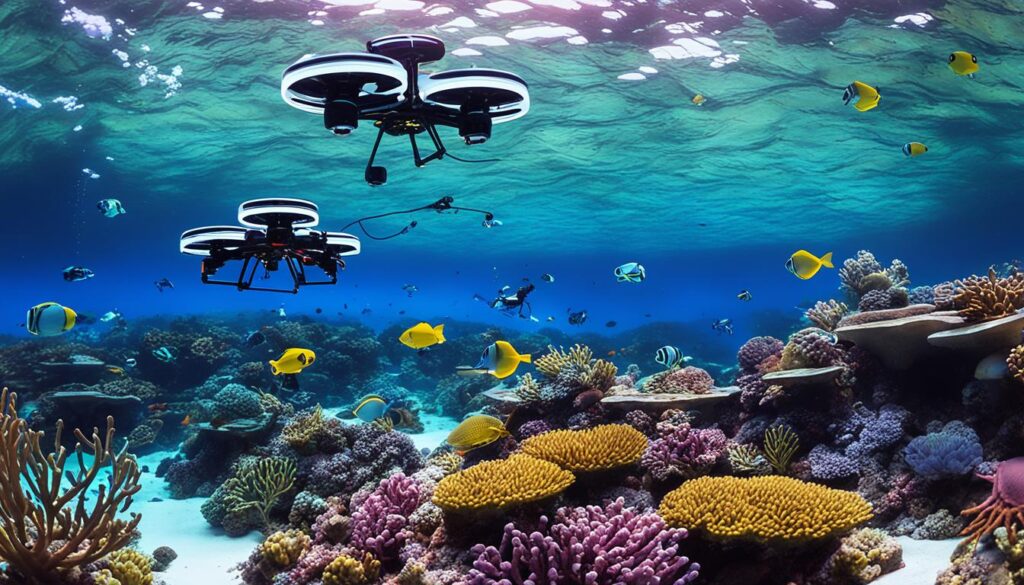
| Challenge | Application of Underwater Drones |
|---|---|
| Monitoring Underwater Pollution | – Efficient surveying of large areas to collect real-time data on water quality and pollutant levels |
| Studying Coral Reefs | – Conducting detailed surveys, mapping coral reef structures, and monitoring reef health using high-resolution imagery and sensors |
| Tracking Oceanographic Phenomena | – Collecting precise data to map and track ocean currents, tides, and temperature variations |
Future Prospects of Underwater Drones in Marine Research
The field of marine research is on the cusp of a technological revolution, thanks to underwater drones. These remarkable devices have demonstrated their ability to transform the way we explore and study the underwater world, leading to exciting advancements in marine science. With the continuous development of underwater technology, the future prospects for underwater drones in marine research are incredibly promising.
Revolutionizing Marine Exploration
Underwater drones have already revolutionized marine exploration by providing scientists with a cost-effective and efficient means of collecting data in the deep sea. These autonomous underwater vehicles can reach depths that are inaccessible to humans, allowing researchers to study underwater ecosystems, marine species, and geological formations in unprecedented detail. As underwater technology continues to advance, underwater drones will become even more capable of navigating complex ocean environments, enabling scientists to uncover new discoveries and gain a deeper understanding of our oceans.
Advancements in Data Collection
One of the most significant contributions of underwater drones to marine research is their immense potential for data collection. Equipped with a variety of sensors and cameras, these drones can capture high-resolution imagery, record underwater sounds, measure water parameters, and collect samples. This wealth of data provides researchers with valuable insights into marine ecosystems, enabling them to monitor changes over time, identify trends, and make informed decisions to protect our fragile ocean environments.
Emerging Technologies
The future of underwater drones in marine research holds exciting possibilities with the emergence of cutting-edge technologies. Advancements in underwater robotics, artificial intelligence, and sensor capabilities are expected to enhance the performance and functionalities of underwater drones. Researchers are exploring the use of swarm technology, where multiple drones work together to accomplish complex tasks, such as creating detailed maps of underwater terrains or monitoring large areas simultaneously. These advancements will enable scientists to conduct more extensive and detailed studies, leading to groundbreaking discoveries in marine science.
“Underwater drones have the potential to unlock a wealth of knowledge about the depths of our oceans, allowing us to study and understand our marine ecosystems in ways that were previously unimaginable.”
Collaborative Research Efforts
Another future prospect of underwater drones in marine research is their ability to foster collaboration between scientists, institutions, and countries. As the use of underwater drones becomes more widespread, researchers can share data, methodologies, and best practices, leading to a more comprehensive understanding of the oceans. This collaborative approach will not only accelerate scientific advancements but also enable the development of international initiatives for ocean conservation and sustainable marine management.
The Uncharted Frontier
Underwater drones have unveiled only a fraction of the vast mysteries that lie beneath the ocean’s surface. As we continue to explore and unlock the potential of underwater technology, new discoveries and scientific breakthroughs await. The future prospects of underwater drones in marine research are limitless, offering endless possibilities for studying marine biodiversity, understanding climate change impacts, and unraveling the mysteries of the deep sea.
In conclusion, underwater drones are set to play a pivotal role in shaping the future of marine research. With their ability to revolutionize marine exploration, advance data collection methodologies, and facilitate collaborative research efforts, underwater drones have the potential to propel us into a new era of marine science. As technology continues to evolve, the possibilities for underwater drones in marine research are boundless, promising exciting breakthroughs and a deeper understanding of our world’s oceans.
Conclusion
The use of underwater drones has brought about a remarkable transformation in the field of marine research. These innovative technological advancements have revolutionized marine exploration, leading to exciting discoveries and advancements in our understanding of the underwater world.
With their ability to navigate the depths of the ocean and collect valuable data, underwater drones have become indispensable tools for marine scientists and researchers. They have facilitated efficient data collection in underwater environments, allowing us to study marine ecosystems and monitor endangered species, thereby playing a vital role in marine conservation efforts.
Furthermore, underwater drones have opened up previously inaccessible areas of the ocean, expanding our knowledge of marine environments. They have enabled us to study underwater geology, map ocean currents, and explore underwater phenomena, contributing to the advancement of oceanography research.
As we look to the future, the potential of underwater drones in marine research is immense. With ongoing advancements in underwater robotics and technology, we can expect further breakthroughs in our understanding of the oceans. These underwater drones will continue to shape the future of marine exploration, conservation, and scientific discovery, paving the way for a better understanding and preservation of our precious marine ecosystems.
FAQ
How do underwater drones revolutionize marine research?
Underwater drones have revolutionized marine research by enabling scientists to explore and study underwater environments more efficiently and effectively. Equipped with advanced technology, these drones can collect valuable data, imaging marine ecosystems, monitor species, and even perform complex tasks like underwater mapping and sampling.
What are underwater drones?
Underwater drones, also known as autonomous underwater vehicles (AUVs), are robotic devices designed to operate underwater without direct human control. They are equipped with various sensors, cameras, and scientific instruments to collect data and perform tasks in marine environments.
What advancements in underwater robotics have contributed to marine research?
Advances in underwater robotics have significantly contributed to marine research. These include improvements in autonomous navigation systems, battery life, sensor technology, and data transmission capabilities. These advancements have enhanced the capabilities of underwater drones and allowed researchers to explore previously inaccessible areas, gather more accurate data, and increase the efficiency and scope of marine research.
How do underwater drones enhance data collection in underwater environments?
Underwater drones enhance data collection in underwater environments by providing a cost-effective and efficient means of collecting scientific data. They can be equipped with a variety of sensors and instruments to measure parameters such as water temperature, salinity, pH levels, and marine life activity. The collected data can then be used to gain insights into marine ecosystems, oceanography, and climate change.
How do underwater drones contribute to marine conservation efforts?
Underwater drones play a crucial role in marine conservation efforts. They enable researchers to study and monitor marine ecosystems, detect and track endangered species, and monitor the impacts of human activities on the marine environment. By providing valuable data and insights, underwater drones help inform conservation strategies and aid in the preservation and protection of marine ecosystems.
What is remote underwater sensing and how does it benefit marine research?
Remote underwater sensing refers to the ability to collect data and perform experiments in underwater environments without direct human involvement. Underwater drones equipped with remote sensing capabilities, such as high-resolution cameras and sonar systems, can remotely explore and map underwater areas, study marine geology, and monitor underwater phenomena. This capability allows researchers to gather critical data in challenging underwater conditions and expand our understanding of the oceans.
What are the applications of underwater drones in oceanography research?
Underwater drones have numerous applications in oceanography research. They are used to study ocean currents, map seafloor topography, investigate underwater geological features, monitor underwater volcanic activity, and study marine life distribution. These drones enable researchers to explore and understand the complex dynamics of the oceans, contributing to advancements in oceanography and our knowledge of the marine environment.
How do underwater drones expand our knowledge of the oceans?
Underwater drones expand our knowledge of the oceans by allowing scientists to explore and study underwater ecosystems in depth. They provide access to remote and challenging underwater areas, which were previously inaccessible to researchers. By capturing high-resolution imagery, conducting scientific experiments, and collecting data, these drones contribute to the discovery of new marine species, the understanding of underwater ecosystems, and the identification of potential ecological threats.
How do underwater drones address challenges in underwater research?
Underwater drones address challenges in underwater research by providing a safe and efficient means of collecting data and performing tasks in challenging underwater environments. They are used for monitoring underwater pollution, studying coral reefs, tracking oceanographic phenomena, and conducting underwater archaeological surveys. Their versatility and advanced technology make them invaluable tools for researchers in overcoming the challenges associated with underwater research.
What are the future prospects of underwater drones in marine research?
The future prospects of underwater drones in marine research are promising. As technology continues to advance, we can expect underwater drones to become more sophisticated, capable of collecting even more precise and comprehensive data. They will likely play a critical role in mapping unexplored regions of the seabed, studying deep-sea ecosystems, and monitoring the impacts of climate change on marine life. The integration of artificial intelligence and machine learning algorithms in underwater drones may also allow for autonomous decision-making and adaptive exploration.

